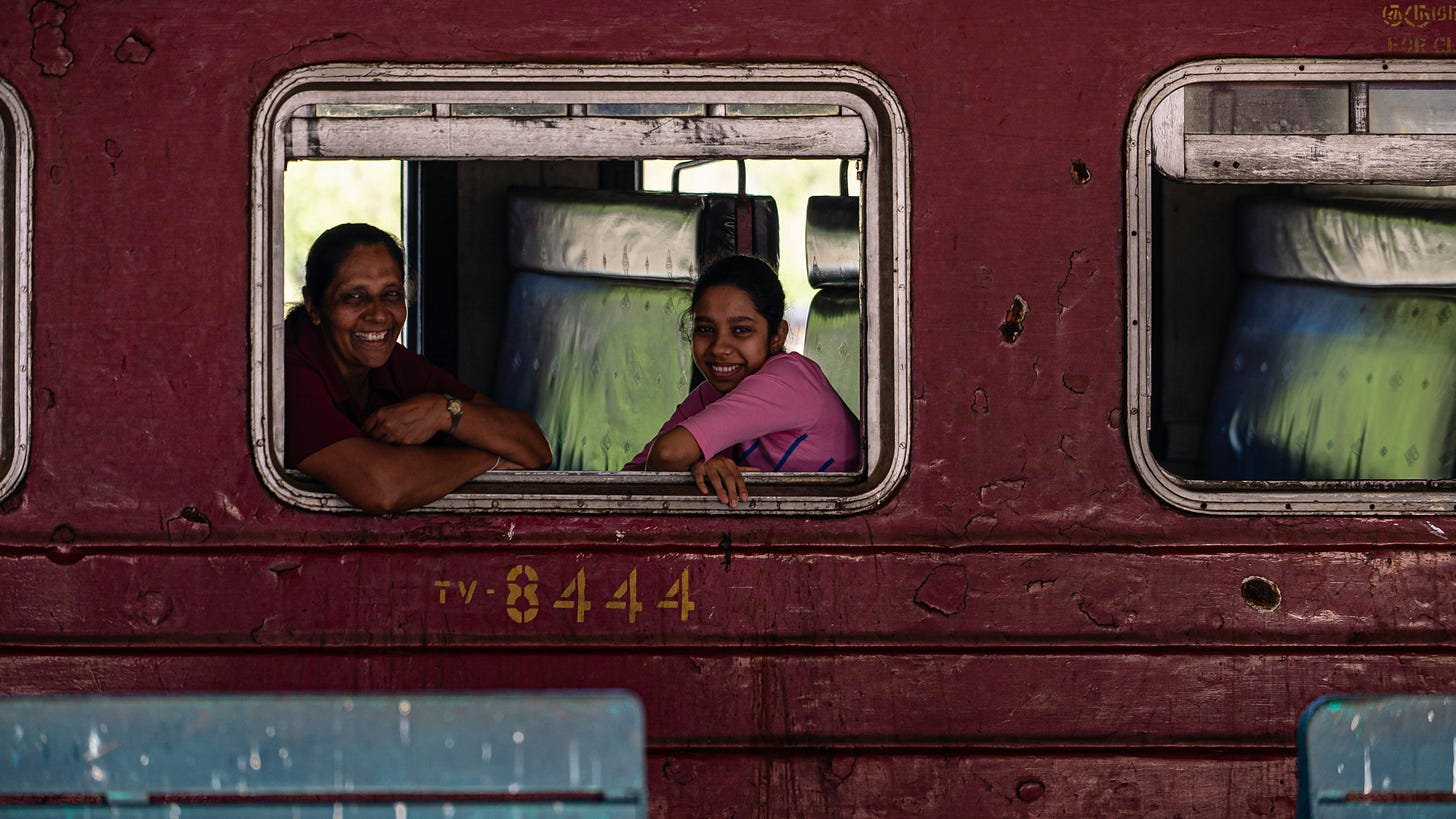
A cricket-loving nation like almost no other, one of the first things that strikes the newly-arrived visitor to Sri Lanka’s capital Colombo is just how much these people adore the game.
At every hour of the day (or night—often in poor light that would have long stopped play at the Oval) seemingly every patch of flat ground hosts a cricket match—be it an official game with players kitted out immaculately in white, or a pick-up affair complete with improvised stumps and a wicket that would no doubt be described as ‘unpredictable’.
In the Pettah market area north of Colombo’s main railway station, every shop—be it a chemist, an electrical store or textile emporium—will also sell cricket bats and accessories. Colourful Sri Lanka cricket shirts (knock-offs, of course) can be bought from every stall for peanuts—indeed if you want to buy one do so here given that they are far more expensive in the tatty souvenir shops found in the more tourist-oriented parts of the country.
On one lazy Sunday towards the end of the trip, I invested in a copy of Sri Lanka’s very own Sunday Times (the first time I’ve bought a newspaper in years). A multi-section treasure much like the UK’s Sunday Times, its cricket coverage was predictably thorough. Alongside reports of the national team’s endeavours (they were at the time on tour in Bangladesh) were lengthy reports and scorecards from club matches, as well as games played between the country’s high school teams.
–
Colombo Fort Railway Station looks rather unpromising from the outside—an apologetic, single-storey white building that fails to suggest this is in fact the hub of Sri Lanka’s extensive railway network.
Inside, past the heavily armed guards who fiercely protect the entrances (Sri Lanka’s civil war may have ended in 2009, but a threat—or fear—of terrorism remains), the station is oddly magnificent: busy but never chaotic, full of commuting workers, scurrying vendors, melodic announcements, and the regular clatter of trains. The high arched roof provides an impression of grandeur, while heavy and clearly ancient wooden doors offer a sense of history. The toilets are unusable but there is a perfectly decent left luggage room, which would come in very handy later on during the trip.
–
Colombo is short on sights. Like so many countries around the world (and I would include Romania, my home, in this category) lists of the best things to see and do in Sri Lanka usually exclude the capital (unless, that is, your visit coincides with an international cricket match. Ours, alas, didn’t).
The Gangaramaya Temple (especially the Sima Malaka located on a small lake) is a worthwhile hour or two, while Galle Face Beach may not be much of a beach (there are thousands of wonderful beaches in Sri Lanka and this is not one of them) but the wide promenade is a wonderful place to watch wealthy Sri Lankans at play. There will be umpteen impromptu cricket matches going on, hundreds of kids flying kites, and large groups of well dressed schoolchildren munching on samosas or water melons.
Galle Face, with its manicured lawns, swish shopping mall and high rise apartment blocks is, somewhat literally, the face that Sri Lanka’s government prefers to show the world—one of modernity, wealth and progress. Less impressive are the hard statistics that belie the mirage. More than a quarter of the Sri Lankan population lives in poverty (defined as people who do not have enough to meet their basic needs).
In just about every corner of the country (Galle Face excepted) it shows. With the economy hitherto in freefall—Sri Lanka’s real GDP fell by 9.2 per cent in 2022 and a further 4.2 per cent in 2023, although it is likely to stabilise this year—hundreds of thousands of people are leaving the country each year. Around half of those departing are women. Remittances now make up around seven per cent of GDP.
–
Our accommodation in Colombo came in stark contrast to the grim macroeconomic data. A truly magnificent house on a quiet street in the south of an otherwise chaotic city it was designed and furnished with the kind of impeccable taste that immediately betrayed the fact that there must be an architect in the family. Enormous bathroom suites carved out of granite vied for attention with the preposterous but delightful wooden four poster bed (all the better for hanging mosquito nets—although these would not be a problem in Colombo).
On our first morning, over a wonderful breakfast of eggs, Sri Lankan coconut pancakes, coffee, strong tea and lashings of fresh fruit, the owner indeed revealed that her daughter had studied architecture and had overseen the renovation of the house. We were the only guests, looked after impeccably by a maid. I cannot recommend the place highly enough.
–
Sri Lanka possesses a relatively well-developed railway network. From Colombo Fort Station, railway lines fan out across the country, heading south to Galle and Matara, north to Puttalam, east to Trincomalee and Kandy, as well as the celebrated mountain line that climbs up to the tea plantations of Ella and Demodara.
Alas for the casual traveller, the destinations (or route) of these trains do not always coincide with yours. Such is the case for those wanting to visit Sigiriya Rock, an ancient rock fortress located in the northern Matale District near the town of Dambulla—close to the very centre of the island.
While a couple of cross-country trains stop each day at Habarana, 15km away from Sigiriya, that’s as close as it gets. Furthermore, the journey takes well over five hours and on the morning train there is no reserved seating. Playing the over-50s card we decided against it, instead calling what would be the first of many cross-country Ubers.
Indeed, perhaps the primary advantage of backpacking at 50 (as opposed to backpacking in your late teens or early twenties) is that you don’t always have to choose the cheapest option.
A (slightly) more generous budget means that you can stay at nice hotels or homestays instead of hostels, eat at better restaurants, seek out more exclusive experiences and—in the case of Sri Lanka—call an Uber every time you need to travel halfway across the country. If you’re lucky, your driver might even have enough petrol to get you to your destination.
Uber offers an official long-distance service in Sri Lanka called InterCity. Open the app, add your destination and the InterCity option will appear—complete with price (our three and half hour, 170km drive to Sigiriya cost the equivalent of €65). In Colombo at least there were drivers aplenty (it would not always be so easy). A young chap arrived promptly in a decent car, and drove us to Sigiriya without a word of complaint (again, it would not always be so).
–
Sigiriya Rock would be the biggest disappointment of the trip. It’s an impressive outcrop standing 180m in height in an otherwise unremarkable plain. Kashyapa I, also known as Kasyapa I or Kassapa I, who ruled the island from 473 to 495 CE, is credited with building a fortress on the summit.
Little of the fortress remains, nor is there much left of the frescoes that decorated the route to the top. There’s a small museum that offers some (but not much) historical context and the view from the top—which we enjoyed at sunset on a cloudless evening—is stunning. It’s worth the climb (which takes around 45 minutes up some often fiercely steep steps dotted with warnings to be quiet in order not to disturb the millions of wasps who call the rock home), but not, arguably, the extortionate cost.
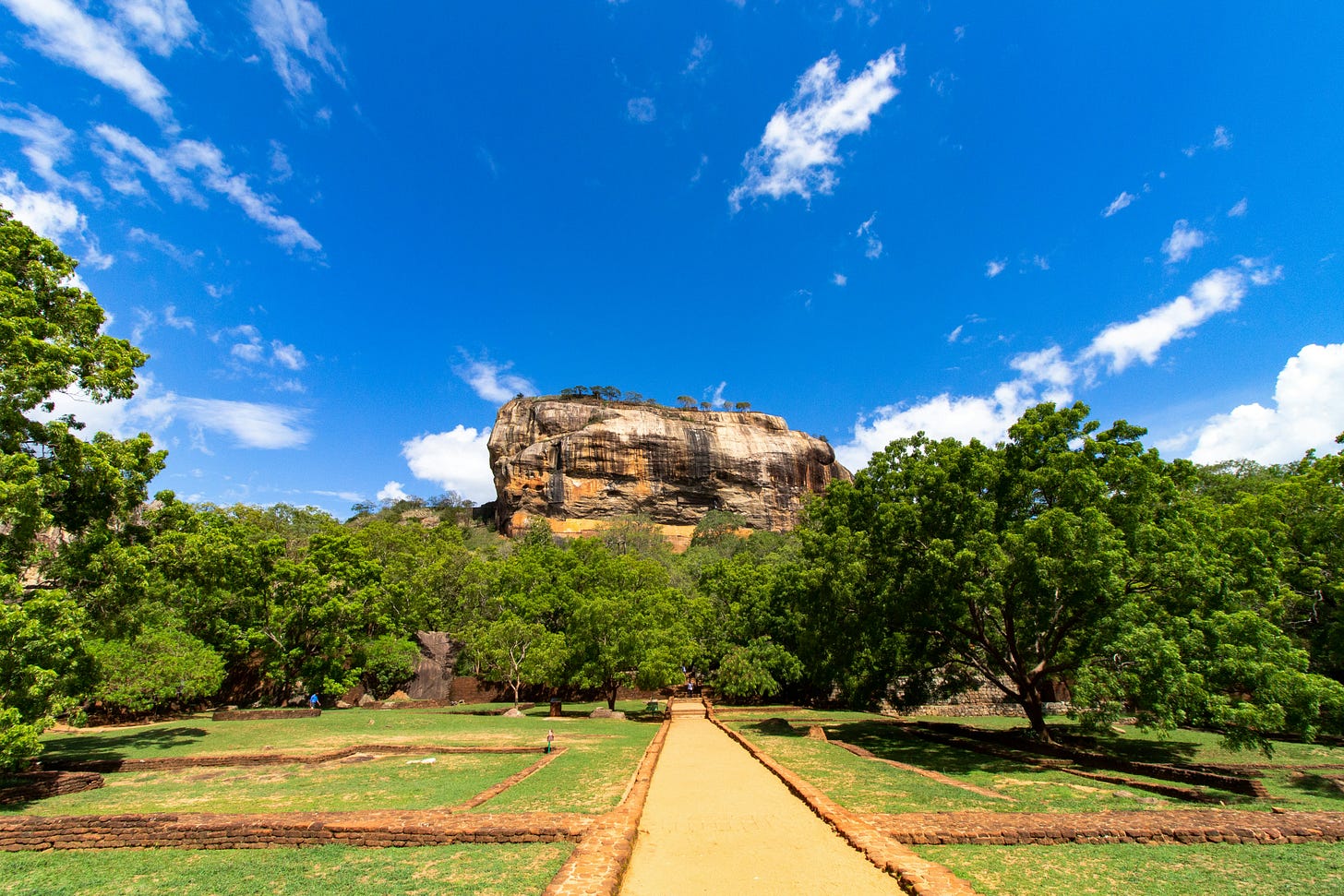
As a foreigner, it will cost you the equivalent of $36 to climb the rock—Sri Lankans pay a tiny fraction of that. For reference, two dollars more gets you a day’s access to the whole of the incomparable Angkor Wat complex in Cambodia.
(For what it’s worth, I’ve never been a fan of two-tier pricing for the same thing. It was common practice in the communist world pre-1989 and remained so, in Romania at least, until the late 1990s. Comically, at a hotel in Poiana Brașov in—if memory serves—early 1998, an English friend and her Romanian husband were on checkout presented with two separate bills for the same room. One bill for her and another, much cheaper bill, for her husband, as if her side of the bed was more comfortable).
–
If Sigiriya Rock was overpriced and somewhat underwhelming, the following day’s elephant safari was anything but—at least as far as Amelia and I were concerned. Arranged by the agreeable owner of our simple but charming accommodation, to keep costs down (backpacking at 50 means a higher budget than usual, not an unlimited one) we shared a jeep with a couple of Germans who—as if keen to blow away any stereotypes, turned up half an hour late.
There are several responsible places to see elephants in the wild in Sri Lanka including Udawalawe in the south of the island (the country’s largest national park) and Yala, also in the south. (Avoid anything marketing itself as an ‘elephant orphanage’ or ‘sanctuary’). We chose Hurulu Eco Park within Minneriya National Park for its proximity to Sigiriya, but also because we had been promised that we would not fail to see tens of elephants.
And we did, just minutes after turning off the main road that traverses the park. An entire family group of a dozen or so elephants of all sizes, grazing in the long grass. Over the course of the next two or three bonecrunching hours (there are no roads in the park, just heavily rutted mud tracks) we were privileged to see 40 or so of these magnificent creatures, some in incredibly close proximity.
Our German companions were not so easily impressed. It’s difficult to gauge exactly what they had been expecting—elephants being paraded in front of them as if at the circus, perhaps?
They insisted the driver find a lake where they appeared to believe there would be thousands of elephants taking water. There weren’t. Wo sind die Elefanten? (Pace Leon Rosselson).
–
Google ‘Hiking Ella Rock’ and you will at once be presented with an array of blog posts and articles that highlight just how utterly shite the majority of the new generation of travel writers really are.
A simple hike becomes an expedition, complete with instructions that make just about no sense. In reality, it couldn’t be simpler. Take a tuk-tuk from Ella to Kitha-Ella railway station before walking along the tracks for 200m and taking the first path to the left. Then follow the path to the top of the rock for some extraordinary views of the surrounding hills, most of which are covered with tea plantations. That’s, ahem, it. There is, admittedly, none of the signage you’d expect to find on hiking routes in the mountains of Europe, but it’s not remotely difficult. Neither, for even a casual hiker, is the walk up—despite what you’ll read.
Far trickier is getting to Ella itself. There’s a train from Colombo (or Kandy)—indeed, it’s the most celebrated train on the island and one of Sri Lanka’s most popular experiences. But finding tickets in the few reserved seating carriages can be difficult, and the journey time from the capital (over six hours) is offputting for many.
From Sigiriya, public transport options to Ella are few and far between. It would have required taking a bus to Badulla, another bus to Kandy, and then either another bus or the train (which is usually already sardine can-full by the time it arrives at Kandy).
We decided to take another Uber. This time, finding a driver willing (or able) to take us was far more challenging than it had been in Colombo.
–
The first driver who actually showed up (after several attempts to hail an Uber had failed) demanded cash up front as he didn’t have enough petrol to get us to Ella. The second driver who accepted simply cancelled the trip when he became aware of our destination.
It ended up being third time lucky—although these things are relative. The driver who eventually took us to Ella couldn’t have been nicer, but his car—a tiny Tata—had seen better days. Cramped into the back seats for the four and half hour trip (190km up and down some at times startlingly sharp hairpins) with our rucksacks on the spare front seat (Tata’s have only tiny rear boots), it was an adventure I’d not willingly repeat.
But at least he had enough petrol.
–
Fortunately, what awaited us in Ella was more than worth the temporary discomfort. Amelia has the fortunate talent of finding the shiniest gems amongst the morass of dreary accommodation options that blight places such as Ella—very much Sri Lanka’s backpacker capital, all hostels, unappealing hotels and dubious homestays.
Perched on a hillside above the town with a picture postcard view of Ella below, Amelia had this time outdone herself. Never have I benefited from a view quite as spectacular as that offered by the large room we were given on the upper floor of a house, the lower portion of which was occupied by the family who owned the place (this place).
Breakfast was a feast—eggs, pancakes, fresh fruit, coffee, tea. The hillside location meant a tuk-tuk was necessary each time we wanted to head into Ella, but the property’s owner had a driver on hand to pick us up anytime we were needed—for a fair price.
Outside of Colombo, Sri Lanka’s own PickMe app (similar to the Grab app found elsewhere in Asia) is useless for hailing tuk-tuks; you will invariably need to take one off the street with all the pointless haggling (and often outright fleecing) that implies.
–
Backpackers are a modern addition to Ella’s economy—that the place exists at all owes itself to tea, not tourism. The town is surrounded by the tea plantations that make a considerable contribution to the island’s economy—around 10 per cent of all tea drunk around the world is grown in Sri Lanka.
Several plantations offer tours—both of the factories that produce the tea and the steep hillsides on which the tea is grown. Halpewatte has been producing tea at Ella since 1940, and is today the largest producer in the region. The factory and plantation tours each cost the equivalent of $10, and both include copious amounts of tea tasting—setting you up to buy vast amounts from the extensive factory shop. Prices at the shop are more than reasonable—outstanding tea at a price well below most of Sri Lanka’s regular shops.
The plantation tour includes the opportunity (indeed, obligation) to try your hand at picking tea. It’s not as easy as it looks, given that it’s only the tips of the plant that need to be picked. It’s hot, backbreaking work. The (almost exclusively) women who do it for a living are special—half an hour picking tea will make you appreciate their work (and your next cuppa). For the English, tea is taken so much for granted that we give nary a thought to where it comes from or to these remarkable women who work for just a couple of dollars a day.
Strikes are currently common among plantation workers, apparently, as pay has not kept up with Sri Lanka’s rampant inflation. Solidarity with each and every one.
–
The Nine Arches Railway Bridge, a short distance south of Ella (it's a 20 minute walk from the centre of town) is as much a part of Sri Lanka’s tourism brand as tea, cricket, and Sigiriya Rock. Ensuring that a visit coincides with a passing train is easier said than done—the timetable is rarely kept, as trains accumulate long (often hours long) delays on the way up from Kandy.
Your best bet is to schedule a visit with a train heading back down—these are more likely to arrive at a time more in keeping with the (purely theoretical) timetable.
We didn’t get lucky, but the bridge is spectacular enough without a train. Instead, gawp at the Instagram idiots risking life and limb for that perfect shot by prostrating themselves in the most unnatural of poses perilously close to the bridge’s edge.
–
Our next destination was Tangalle, on Sri Lanka’s south coast. There are buses from Ella, but keen to stop on the way at the spectacular Ravana Falls, we again chose the Uber option. There were plenty around, and our driver had both a decent car and petrol—an unexpected bonus.
Less a resort and more a busy, medium-sized town, Tangalle offers fantastic food (probably the best on the island—some of the fish, including an entire Indian Ocean snapper cooked in a sweet sauce, was glorious) and easy access to several all but deserted beaches.
The best of these is probably Slient Beach, a 15 minute tuk-tuk ride from Tangalle. The golden sand was soft and pristinely clean, the water lively. The Indian Ocean in these parts can be rough even in the best of weathers (and we were blessed for most of the trip with hot sunshine). A reasonably strong swimmer, on one occasion I was nevertheless spun around as if in a washing machine by an enormous wave that appeared out of nowhere. I wryly smile about it now but it was utterly terrifying at the time.
Our home in Tangalle was yet another gem (thank you again Amelia) complete with a small but gorgeous swimming pool and lush gardens. The bathroom was open air—showering under the sun (and moon) was a first for this correspondent.
–
The welcoming committee at our final stop, Benthota, halfway between Galle and Colombo, was an enormous water monitor crossing a bridge, at least two metres in length (the monitor, not the bridge) and genuinely scary—it looked for all the world like a crocodile. Monitors don’t, apparently, view humans as a food source, but they do occasionally inflict painful bites. We chose to bide our time and wait for it to return to the water. Walking from our hotel to the beach each day became a rather anxious affair after that, but we only saw one other; its long, scaly tail disappearing into a sewer pipe.
We had again tried to take the Uber option in order to travel from Tangalle to Benthota, but this time drew a blank. The lovely woman who ran our small hotel in Tangalle instead arranged a car and driver for us (every accommodation provider in Sri Lanka will have a driver on hand if need be).
He explained that on the south coast Uber is simply not welcome—cars are regularly attacked by taxi and tuk-tuk drivers. He also gave us some insight into Sri Lanka’s economic woes—tourism has yet to recover from the impact of Covid-19 and those who rely on tourists for their income are struggling.
–
The wide Benthota beach offers golden sand and warm water that is still lively (it’s a hugely popular surfing venue) but far less perilous than we had found at Tangalle, given that the waves tend to break long before reaching shore.
Accommodation was again superb—a new, small hotel with a large swimming pool again set well away from any unwelcome noise. Breakfast was the usual Sri Lankan feast on steroids. Served on the balcony, it took two members of staff a good ten minutes to serve the various dishes offered, from eggs and noodles with mild curry to pancakes, toast, and the obligatory plate of fresh fruit.
On the subject of fruit, Amelia was eager to try durian, a notoriously pungent fruit found across much of South and Southest Asia. We found some in a market, duly bought one, and having appealed to our host for help dismantling it, were unpleasantly surprised to discover that the stories of its infamous smell (think rubbish that’s been sitting in the sun for a week—you’re still not even close) were entirely well-founded. It tasted no better.
Still, YOLO, as the under-50s say.
–
In the hills above Benthota is the former home of Bevis Bawa, a polymath who was at once one of the most renowned landscape architects in Sri Lanka and served as the aide-de-camp to four governors of Ceylon.
Bawa inherited the Brief estate, a rubber plantation, in 1949. He made it his home and extended the gardens—which became so popular he was commissioned to landscape the gardens of Ceylon’s wealthy and powerful.
You may need to bang on the front door of the Brief villa a few times before the caretaker and guide deigns to open—he could well be showing other guests around the sumptuous garden. A stroll around the stunning grounds—all hidden lawns, meditation spots and water features—makes for a highly pleasurable hour, while the villa itself is an elegantly simple modernist building of which the highlight are the polished cement floors that cool the building in the otherwise stifling heat.
The vaguely homoerotic, voyeuristic art on some of the walls, featuring young men not wearing much, points to a possibly complicated private life—to put it diplomatically—but Bawa certainly knew how to landscape a garden.
–
By now desperate to try out a Sri Lankan train—if only for a couple of hours—we took a day trip from Benthota’s gorgeously simple railway station to the city of Galle. Tickets are still strictly analogue—pre-printed pieces of cardboard with hand-scribbled embellishments. The train was adequate, second class at least was not at all busy (third class was standing room only, and there’s no first class) and the fans attached to the roof of the train were working.
Arriving at Galle station was the only time during the entire trip that the omnipresent taxi and tuk-tuk drivers felt overly aggressive. Several tried to tell us that Galle Fort—that part of the city visitors come to see—was some distance from the station. We’d done our homework, and knew it was a five minute walk (passing, on the way, Galle’s international cricket ground).
Galle Fort was built first in the 1580s by the Portuguese, then extensively fortified by the Dutch a century later. Enclosed within sturdy stone walls, the fort features a grid-like layout, its streets are lined with an array of colonial buildings, from administrative offices and churches (both Protestant and Catholic) to warehouses and merchant houses, many of which have been meticulously preserved or restored—often as shops, hotels or restaurants. Almost all of these buildings boast thick walls, tall windows, and terracotta roof tiles, reflecting the adaptations made by the colonial settlers to Sri Lanka’s tropical climate.
One of the most successful restorations is The Bungalow, a hotel whose restaurant serves exceptional food (crab curry, oysters, lobster) in a gorgeous courtyard setting. A far more modest eatery, tiny Coconut Sambol, meanwhile serves the most refreshing homemade ginger ale in all Sri Lanka—so strong it’ll blow your socks (and much else) off.
–
A late night flight home from Colombo (so late in fact it was early the next morning) meant that we had one final day to spend in the capital. But first we had to get there. The train left far too early, so we again settled on an Uber. Again the driver complained that he may not have enough petrol to take us the full distance—the ‘low fuel’ warning light was already flashing when he picked us up.
Fortunately, we made it to Colombo—presumably running on fumes alone for the final few kilometres.
After depositing our backpacks at the left luggage facility at the station and heading to quite the finest shop in all Sri Lanka (Barefoot, which at the rear has a lovely garden cafe) we wearily settled in for a final splurge—a day and evening’s eating and drinking (my first draught beers in two weeks) around the Colombo Hilton’s pool.
Why not? After a fortnight’s hectic travel, we’d earnt it. Besides, when you backpack in your 50s you can (just about) afford it.
–
Notes
We visited Sri Lanka at the end of February and beginning of March, towards the end of the dry season. There were several days when the temperature was uncomfortably high, even in the higher and cooler parts of the island, such as Ella.
We flew (from Bucharest) in and out of Colombo with FlyDubai (Emirates low cost outfit), changing in Dubai. Tip—request the gluten free meal (which you need to book in advance). It’s far superior to the standard meal. Local SIM cards can be bought at the airport and are insanely cheap. Colombo Airport is quite some distance from the city—take an Uber, not a regular taxi, unless you fancy trying out your negotiating skills. Have some rupees on hand to pay the motorway tolls.
Outside of Colombo and Galle payment by card is both unwelcome and in many places simply impossible—and that includes all but the largest hotels. Make sure you have plenty of cash on hand. Finding an ATM in some places (Sigiriya for example) is tiresome.
Something of a self-declared beer snob (preferably draught, bottled if I must, never from a can), Colombo was the only place in Sri Lanka with a reliable source of draught beer (usually Lion, the perfectly adequate local lager). Instead, I quickly became a ginger ale addict. Sweet and spicy the retail brands are broadly fine but good bars and restaurants will make their own. It’s relatively expensive but sensationally tasty. I had an alcoholic uncle who managed to reform his ways by drinking ginger ale—I can now understand how he managed to do it.
Sri Lankan food is delicious and not as spicy as you would expect and with the exception of dishes such as biryani which are spicy ab initio, every restaurant in which we ate was happy to accommodate Amelia’s ‘zero spicy please’ requests. I think I ate prawns (or something with prawns in it) every day. There’s not much meat on offer in regular Sri Lankan restaurants—but the vegetable, fish and seafood curries are so good you’ll not miss it. For vegans and vegetarians, it’s paradise.
–
We visited (not a definitive list)
Colombo
Pettah Market
Jami Ul-Alfar Mosque
Gangaramaya Temple
Galle Face Beach
Old Dutch Hospital
Sigiriya
Hurulu Eco Park (Elephant Safari)
Ella
Nine Arches Bridge
Ella Rock
Ravana Falls
Tangalle
Tangalle Beach
Silent Beach
Galle
Galle International Cricket Ground
Galle Fort
Benthota
Benthota Beach
Sunflower Arts & Crafts
All photos by and © your correspondent unless otherwise stated.




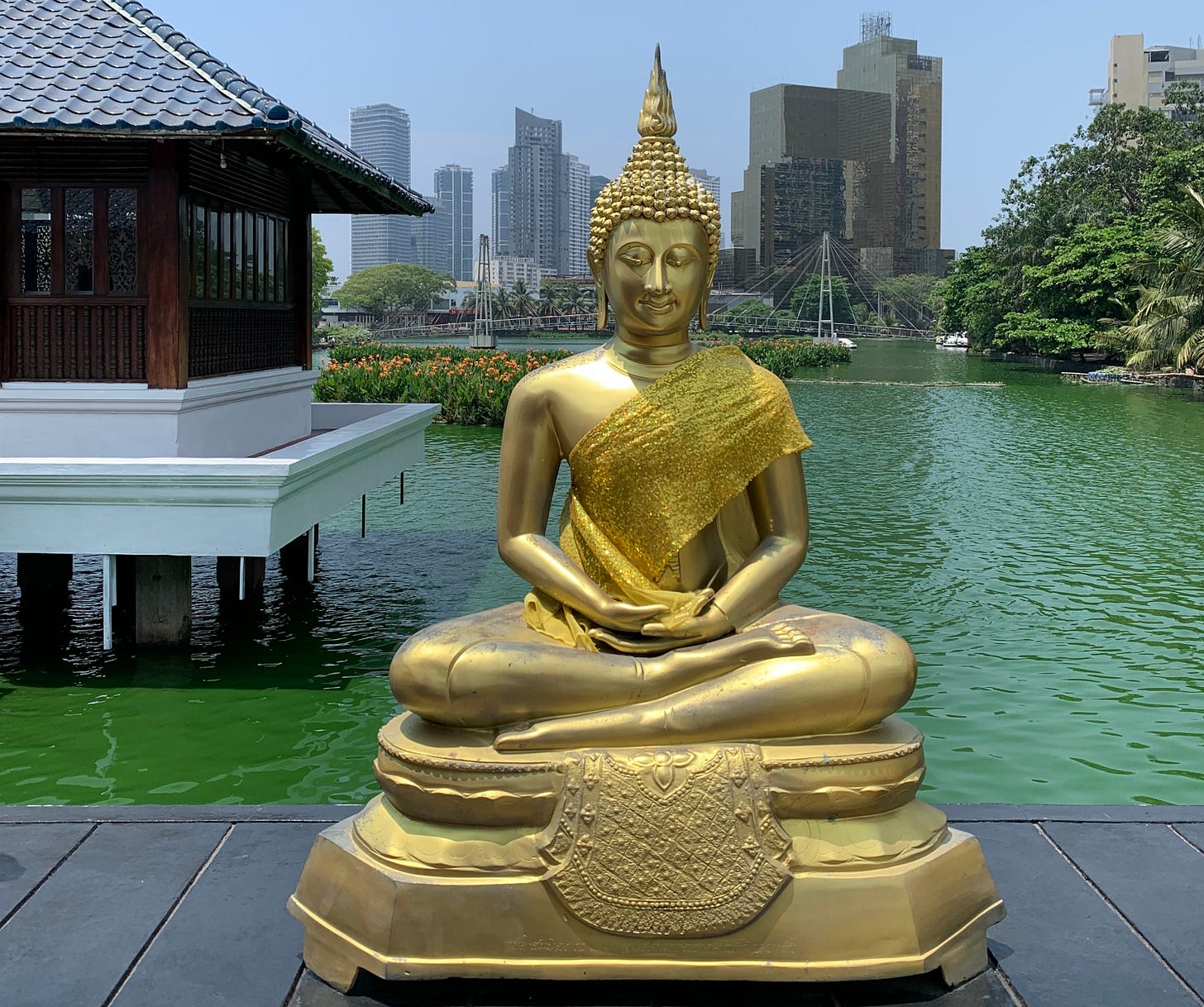
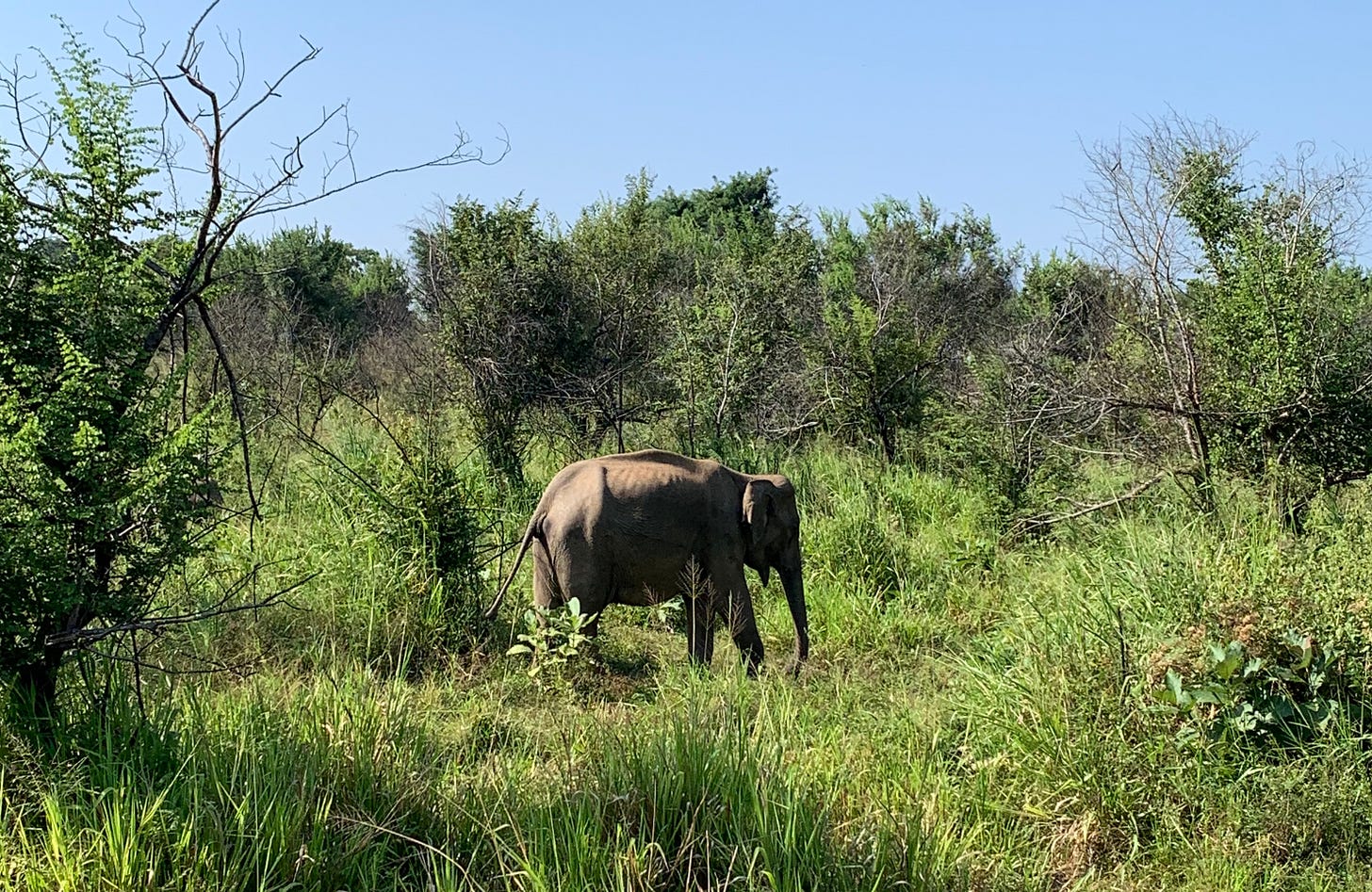
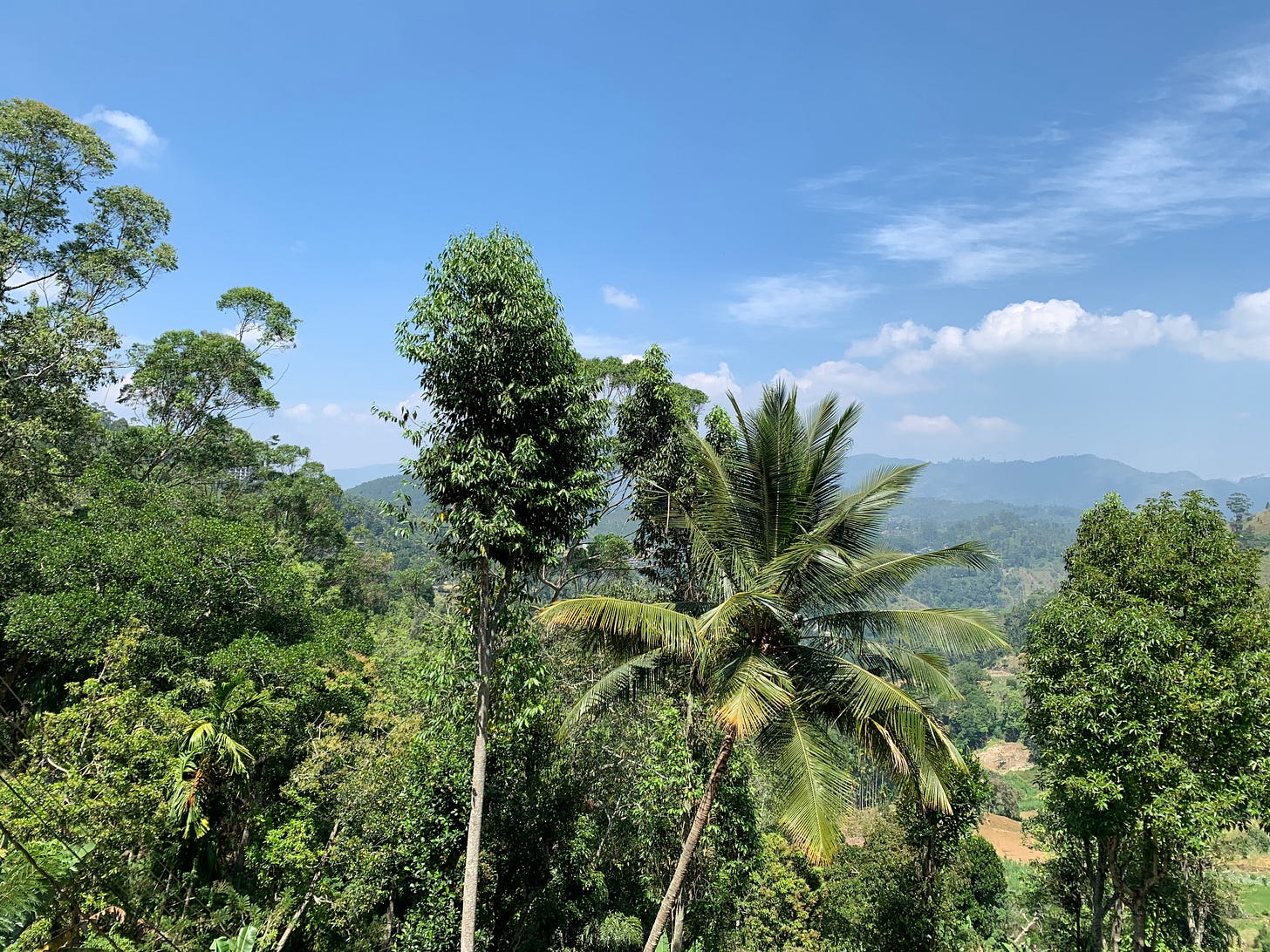

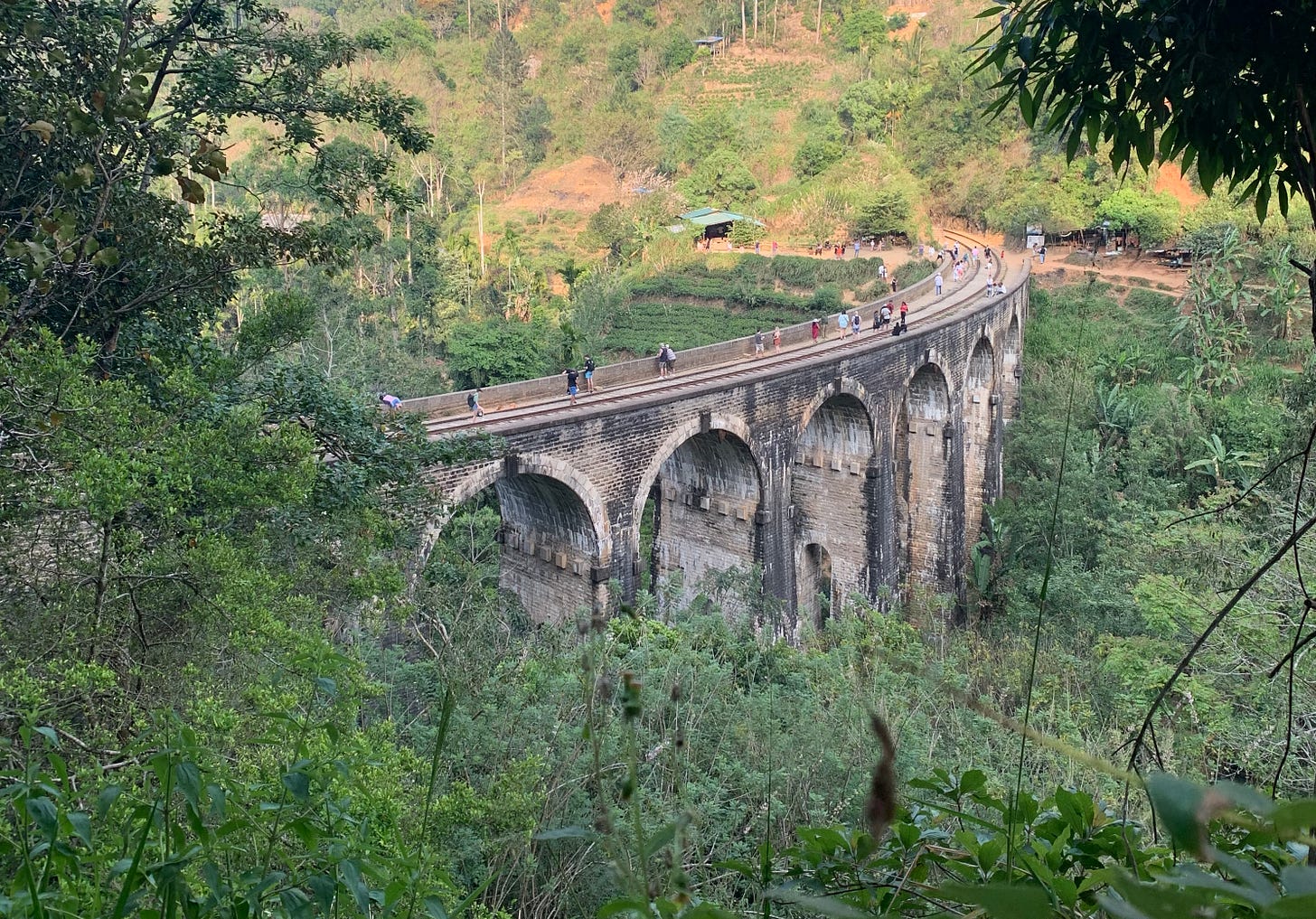

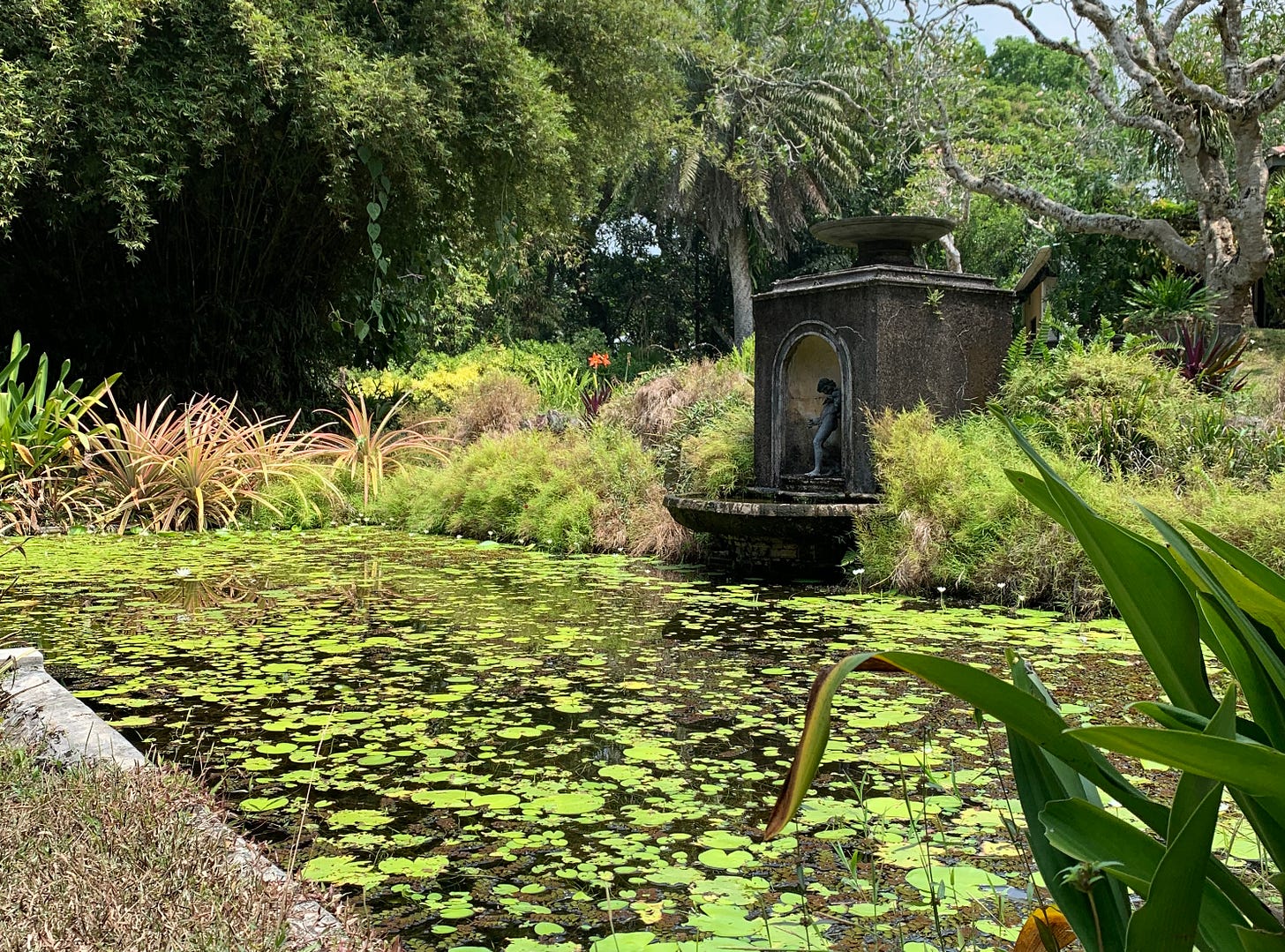
Ok Craig, this is brilliant. REAL travel writing. But tell me (now feeling about 100 asking this): how can I share a link to it on X? Obviously with plug to follow you on substack 🤨